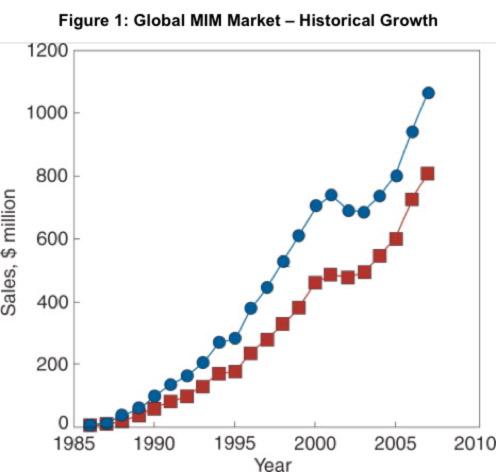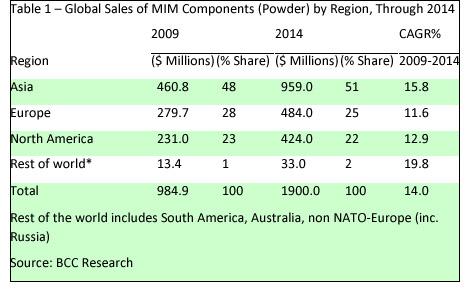
Posted on 12/18/2012 3:42:20 PM PST by null and void
Metal injection molding (MIM) is experiencing a worldwide boom, with an estimated market worldwide of more than $1 billion per year, and compound annual growth rates estimated to be as high as 20 percent. This booming demand for MIM is primarily attributed to the technology's significant cost savings compared to the use of machining or electrical discharge machining. Growth drivers, especially those resulting from medical and firearms industry trends, means that strong MIM technical players are in a good position to bring significant value to customers.
MIM technology is used to form a near net-shape metal part by consolidating metal powder in a special sintering process. The lack of raw material waste, as well as reduced cycle times, can reduce costs by more than 50 percent. While the technology suffered from a shaky technology de-bugging period between its launch in 1970s and the new millennium, several players have now advanced MIM technology to the point that it is currently seen as a strong and reliable solution for overcoming several important economic challenges.

The explosive growth rates have been escalating as the technology receives increasing acceptance for high volume-manufacturing of tightly toleranced small metal components. The American MIM market is estimated at $250 million, with 40 manufacturers in contract manufacturing and more than 10 original equipment manufacturers (OEMs) running captive operations. European demand is approximately $350 million, while the market in Asia, with China leading the growth, is approximately $550 million.
Firearms and medical segments see MIM as attractive option
Firearms and medical applications are the two main segments of MIM demand. Firearms OEMs made the transition to broad sourcing in MIM more than a decade ago, and continue to have growing interest in containing costs and expanding production. Despite (some say because of), the recent economic downturn, the US firearms industry has grown, and background checks for gun sales reached a record high in 2011. Domestic MIM players have a significant advantage over international players in firearms due to ITAR regulations, and those with an ability to respond to the recent ramp up in firearms demand have made significant strides in organic growth.
For example, Parmatech Corp.'s unique MIM capabilities give manufacturers the ability to make weapons from a range of materials using the same tooling, a feature not possible with casting or forging. Parmatech offers a MIM process that can use 4140 and MIM-4605 carbon steel, and 17-4 and 420 stainless steel, all with the same tooling.
By using this MIM process, firearms manufacturers can form several separate parts into one, consolidating a weapon's mechanical components and reducing the component count. This significantly reduces development time and effort and improves supplier tracking. Producing multiple component parts that operate smoothly together is key to the modern firearms manufacturer. As modern weapon manufacturers design sophisticated firearms with numerous interlocking moving parts, they are turning to MIM to produce high volumes of components that can be assembled together without the need for costly machining and gunsmithing.
Medical MIM applications are also on the rise, primarily driven by a macroeconomic focus on dramatically reducing healthcare costs. While the European and US healthcare markets are somewhat mature, the global aging population creates opportunities for the medical industry. According to The Centers for Medicare and Medicaid Services, healthcare spending growth in the US will continue to grow more quickly than GDP for the foreseeable future, despite economic downturn periods.
For example, Parmatech is using MIM for parts used in manufacturing bariatric and laparoscopic instruments, including articulation gear for varying the direction of the working end of the device. The company is using MIM to produce complex, three dimensional shapes that are difficult or near impossible to manufacture using conventional fabrication technologies. MIM provides for complex shapes in a high-volume manufacturing process, and supports the drive toward miniaturization of surgical devices and lowered costs for healthcare equipment. As a result of the trend toward miniaturization, most of the parts made with MIM technology weigh less than 50 gm, and can be additionally lightened by adding holes or pockets without sacrificing strength.

In addition, as US and European OEMs seek to penetrate emerging markets and the BRIC (Brazil, Russia, India, and China) players, cost pressures become the primary success driver; thus, many medical OEMs are looking to cost-saving technologies like MIM with renewed interest.
Figure 1 illustrates the growth in MIM sales over the past 25 years. The upper curve traces global powder injection molding (PIM) annual sales versus calendar year and the lower curve shows the corresponding metal powder injection molding (MIM) contribution.
Macroeconomic drivers strongly support continued MIM growth. Table 1 illustrates the projected growth rates, with the global MIM market projected to grow from $985 million in 2009 to $1.9 billion in 2014, representing a 14 percent compound annual growth rate (CAGR). In North America, the market for MIM product is projected to grow from $231 million in 2009 to $424 million in 2014. In Europe, the market for MIM product is projected to grow from $280 million in 2009 to $484 million in 2014.
With such clear-cut macroeconomic and socioeconomic growth drivers, strong technical players in MIM can expect to bring more value to customers than any of us ever imagined.
Not 3-D printing, but interesting...
Thanks. Outside of a couple newsletters and websites, I get most of my technical news from FR.
Thanks for this.
I operated a small plastics injection molding company back in the 70s, but had never heard of MIM.
I just looked it up on Wikipedia and see that they use the same plastics injection machines, but use metal powder added to a wax or plastic.
They later burn off the plastic.
The interesting twist is you could weld dissimilar metals and apparently it works without de-laminating of the different alloys...
Maybe it’s time to come out of retirement?
There’s plenty of equipment available from all the dead companies...
Very interesting to say the least!
One gigantic question, with China’s dismal manufacturing quality record, are they going to be the “go to” place for MIM? I can see China parts returning to powder because they substitued a proven binder or pressure for something saving less than a fraction of 1 Cent per unit.
Hmmmmmm. A clever operator could adjust the materials on the fly. Make the working surface hard, and the backing material tough, for example.
I’ve seen a process similar to what you describe used to build up worn crankshaft journals. They were re-ground afterward. This was back in the ‘70s.
Go here... Way cool...
https://www.youtube.com/watch?feature=player_embedded&v=ojyEjHY2tOU#!
“Maybe it’s time to come out of retirement?”
______________—______________________
NO WAY! I have even retired from America, the USSA.
MIM is huge in firearms lockwork parts. S&W revolvers now have their hammers, triggers, rebound housing, cylinder stop are all made from MIM. Their springs are still conventional - coil springs and a flat spring. The hand looks like tool steel or some such.
Ruger uses a lot of investment casting for their frames, but I think the guts are MIM’ed.
The nice thing about MIM is that you get so close to your finished size and finish, it is quite remarkable. No machining marks at all.
Oh, and 4140, 17-4PH and 420 are all used in firearms manufacturing.
I just finished a barrel made from 420. Polished up very, very nicely. Better than 416, I think.
Disclaimer: Opinions posted on Free Republic are those of the individual posters and do not necessarily represent the opinion of Free Republic or its management. All materials posted herein are protected by copyright law and the exemption for fair use of copyrighted works.